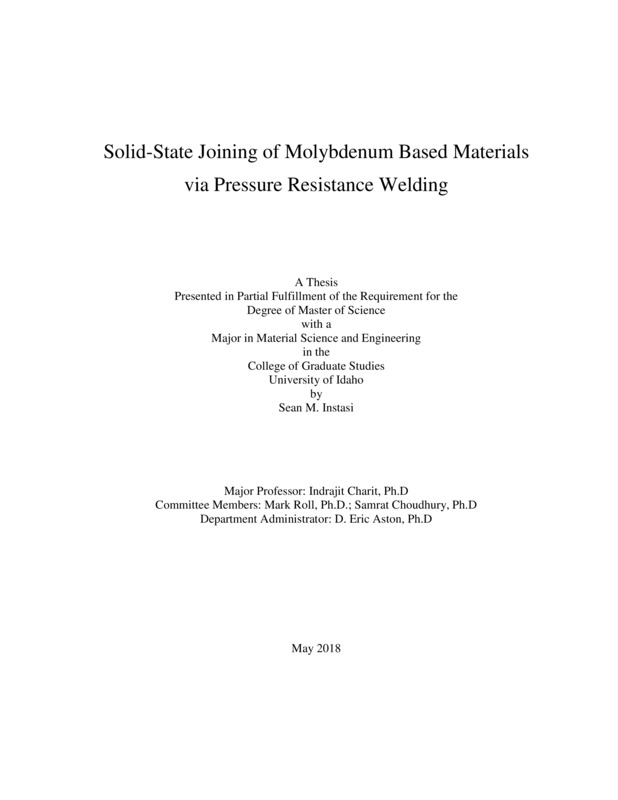Solid-State Joining of Molybdenum Based Materials via Pressure Resistance Welding
Instasi, Sean. (2018-05). Solid-State Joining of Molybdenum Based Materials via Pressure Resistance Welding. Theses and Dissertations Collection, University of Idaho Library Digital Collections. https://www.lib.uidaho.edu/digital/etd/items/instasi_idaho_0089n_11403.html
- Title:
- Solid-State Joining of Molybdenum Based Materials via Pressure Resistance Welding
- Author:
- Instasi, Sean
- Date:
- 2018-05
- Keywords:
- Joining Molybdenum Mo-La Pressure Resistance Welding Solid-State Joining TZM Welding Molybdenum
- Program:
- Chemical and Materials Science Engineering
- Subject Category:
- Materials Science
- Abstract:
-
Refractory metals and materials exhibiting high temperature stability have become more desired in various Generation-IV terrestrial nuclear reactors, space fission reactors, nuclear thermal propulsion reactors, and other high temperature industrial processes. For nuclear reactors, these materials must exhibit high temperature strength, excellent creep resistance, high temperature fatigue resistance, irradiation resistance, and coolant compatibility. Some of the potential high temperature materials include ferritic-martensitic (F/M) steel alloys, oxide dispersion strengthened (ODS) steels, and some refractory metals such as molybdenum and tungsten.
The use of refractory metals in various structural applications can often be limited by their poor weldability characteristics when traditional fusion welding methods are employed. The current research has been focused on exploring pressure resistance welding (PRW) for joining molybdenum-based materials. PRW is a solid-state joining technique (no melting) which combines uniaxial pressure and localized resistive heating to join specimens at their interface. Previous research on PRW has been effective in joining ODS alloys (MA 957, MA 956, and MA 754), F/M alloy HT9, and tungsten. Three molybdenum alloys, including pure molybdenum, TZM (precipitation strengthened by TiC and ZrC), and Mo-La (dispersed with lanthanum oxide particles), were examined in this work. The main objective of this research was to optimize the PRW technique applied to Mo-based materials by varying welding parameters (applied pressure, current, and time) and study the weld microstructure and mechanical properties.
Upon PRW, optical microscopy, Vickers microhardness, transmission electron microscopy, and scanning electron microscopy were used to characterize the quality of welds. Pure molybdenum welds exhibited dynamic recrystallization and grain growth throughout the weld zone. TZM welds exhibited dynamic recrystallization but did not have any significant grain growth. Mo-La welds exhibited limited dynamic recrystallization and grain growth and showed the best hardness profile throughout the weld. Both pure molybdenum and TZM welds showed decreases in hardness throughout the weld zones compared to the base materials, whereas Mo-La showed a slight increase in hardness throughout the weld zone. Overall, PRW appears to be an effective solid-state welding technique for joining molybdenum based materials although further studies will be needed to fully assess the promise of PRW as an enabling technology for key applications.
- Description:
- masters, M.S., Chemical and Materials Science Engineering -- University of Idaho - College of Graduate Studies, 2018-05
- Major Professor:
- Charit, Indrajit
- Committee:
- Roll, Mark; Choudhury, Samrat
- Defense Date:
- 2018-05
- Identifier:
- Instasi_idaho_0089N_11403
- Type:
- Text
- Format Original:
- Format:
- application/pdf
- Rights:
- In Copyright - Educational Use Permitted. For more information, please contact University of Idaho Library Special Collections and Archives Department at libspec@uidaho.edu.
- Standardized Rights:
- http://rightsstatements.org/vocab/InC-EDU/1.0/

